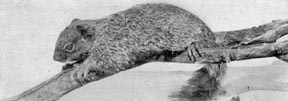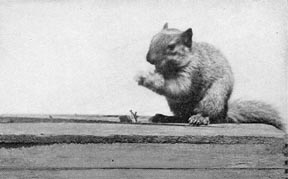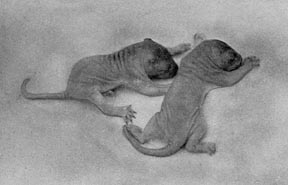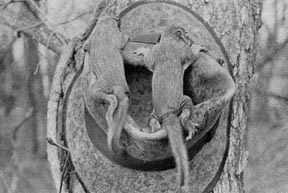FOXY
page 113
When the Naturalist and his family moved to their home in the little wood, there were few wild creatures to be seen, for the previous occupant had been fond of a gun. Such as still lived about were very shy and seldom went abroad when human beings were in sight. There was no gun in the family of the Naturalist, neither was there a cat nor a dog, for the newcomers very much desired to cultivate the friendship of the little animals which lived thereabout. They planted mulberries, cherries, and various other fruits for the birds, put up nest boxes, and provided a regular water supply. Strangers were no longer permitted to shoot and neighbors’ dogs were not encouraged to visit the premises. The little creatures soon noted the change, and gradually learned that the little wood and the Naturalist’s home grounds were a haven of refuge, and that special attractions were offered to make them at home there. They soon lost fear and would play about on the lawn, or scamper through the trees, as the case might be.
When the squirrels began to come to the dooryard for nuts that grew on the big walnut, and rabbits played on the lawn, while the birds sang gaily overhead, the Naturalist decided to call the place “Tamakoche,” which, in the language of the Dakota Sioux Indians, means, “His own country,” or “His own land.”
The fox squirrel of the Mississippi valley is among the largest of American squirrels, and for a time was threatened with extermination. It is becoming established in cities and towns and in some country districts, where it is protected, so that it has been increasing in numbers again the last few years. There were but few wild ones left in the little wood, and they were not often seen for several years. At the least alarm they would flatten out on a limb and were not easily seen from below. But since they were no longer molested, the growing families soon repopulated the whole neighborhood, and squirrels became so common that neighbors complained of their depredations in carrying away corn from the cribs in winter or gathering the ears from the fields in autumn.
The Naturalist and his boys often watched the squirrels gathering the nuts from the big walnut tree which overhung the “Bughouse,” as the two-room laboratory and study was called. They would begin their harvest early in the fall, even before frost had loosened the nuts. Climbing the tree, one would find it an easy matter to reach the farthermost tip of a branch, if need be, in order to get the desired nut. He would grasp the nut firmly in the mouth and climb back to a flat place near the body of the tree. They calmly sitting on his haunches, he would deliberately remove the husk, scattering the bits about the base of the tree. When the nut was free from its outer covering, he would run lightly down the tree and scamper away two or three rods, and quickly bury it in the ground. Again and again he would repeat the process, often more than a dozen times in half an hour. With half a dozen squirrels at work, the Naturalist’s boys had to be very watchful or they would find no nuts lift when they came to gather their share. It is this nut-planting propensity of the fox squirrel that has had much to do with the planting of the original hard wood forest in the Mississippi valley. A squirrel will plant many more nuts in a favorable season than he can ever use for his own food. The frost of winter will crack the hard shell, and the nut is just the proper distance below the surface to enable the seedling to establish itself most favorably. Some species lay up their winter supply in a hollow tree or other favorable situation, where the whole hoard is kept together, but a fox squirrel will gather nuts from many trees, and plant them in every direction around the tree where they grew.
While it was fun to see the little animals gathering the nuts and putting them away for winter, it was vastly more interesting to see them dig them out in the dead of winter when the snow lay deep upon the ground. They would often climb the tree and start from a similar position to the one they had occupied when about to bury the nut the previous autumn. Without hesitation one would run down the tree and directly to a spot where a nut was buried. Then the snow would be made to fly in every direction, although the squirrel would pause a moment now and then to look about to guard against a surprise. Very seldom did one miss finding the nut in the first place where he began to dig. The Naturalist often wondered whether by means of a keen scent he was able to find where the nut was buried, or whether there was a sort of subconscious memory that led him back to the identical spot where he had laid away his treasure several months before. When he had found the nut, he would again climb the tree or some other convenient object, and with his sharp teeth gnaw open the hard shell and make a dinner from the contents. Sometimes during severe and stormy weather the squirrels would not be seen about for several days, but the first bright day they would be playing about among the trees and seeking for food.
The old squirrels occupy a very similar nest in winter to the ones they use in summer. If a convenient hollow is at hand in some tree at a safe height from the ground--which is seldom less than fifteen or twenty feet--they will carry in strips of bark and make a very comfortable bed. The squirrels frequently appropriated the boxes which the Naturalist had built for screech owls and flickers, for winter nests, though they usually retired to the wood to rear their families. If there were no satisfactory cavity, a nest of dry leaves would be built high in a treetop. These nests were very cleverly formed, with the leaves so arranged as to give a shingled effect, and shed the water very effectively. The spring nests in which the young were brought forth were built more substantially than were those which served for mere shelter. For the nursery nest a foundation of coarse twigs was sometimes laid, which gave it somewhat the appearance of a crow’s nest at a little distance. Inside this outer layer of sticks were several layers of coarse leaves, and all was lined with strips of bark, which were finely cut. The top of the nest was shingled over with leaves to shed the rain, as already described, and at one side there was a small opening just large enough to serve as an entrance for Mother Squirrel.
In Iowa the young are usually born in late March or April. Sometimes there will be only one, while there may be as many as five, but the Naturalist found more nests with two young than with all other numbers put together. The new borne young are very small and naked and blind, looking much like baby rats or mice. They grow rapidly, however, and soon begin to don their furs, which gives them more resemblance to their parents.
When the Naturalist or the boys would find a nest, the mother would usually move her young before the next visit. She would depart in haste when they approached, and remain at a safe distance during their stay.
One spring the boys decided that they must have a pet squirrel. They could not be quite content with the wild ones that came about the house and gathered their nuts, but which would never permit an intimate acquaintance. It was seldom that any wild creature was kept long in captivity. As soon as any unfortunate which chanced to need assistance was able to care for itself, it was released, and the few young that the boys did care for in order to get them entirely tame, were permitted to have their freedom from the start.
When it was decided that they would have a pet they began scouring the woods for nests. They soon found one, but the young were so small that one of them just filled the hollow of Melvin’s hand, and it did not even have its eyes open or have a trace of hair. Of course they knew it would not be possible to rear one so young, and Mother Squirrel took good care to move to a new neighborhood after their visit. By this time, however, squirrels were common in the neighborhood, and it was not long until they found one with its eyes open and all its clothes on. They soon found that they had undertaken quite a task, for the little fellow must be fed very often. For a time they gave it nothing but fresh milk, but it was not long until it would eat bread and butter, or a bit of honey in the comb, or a nutmeat, if the boys would crack the shell.
In the shed they made a warm nest for “Foxy,” for that was his name. For a while he slept much of the time, but as he grew older he would spend more time in running about the house. If he chanced to find a piece of cake to his liking, he would seize it and scamper upon a chair or a box and help himself. In the open air a fence post furnished a very satisfactory dining table. Sometimes he would sit on Freddie’s shoulder and nibble away at his stolen dainty, for Freddie and Foxy were very good friends. After a time he tired of a nest which the boys had made for him and built one after his own plans, in a plum tree near the kitchen door. He now lived in the trees like the other squirrels, but he had not forgotten that there were good things to eat in the house. It often happened that when some one opened the door to come in, Foxy would dodge in also. When he slipped in he always made investigation to see whether the dining table was set, and if it was, to help himself to what he wanted. The butter tempted him especially, and Foxy and Mrs. Naturalist soon developed unpleasant differences on this account. The boys and their father always enjoyed Foxy’s visits, but not so the mistress of the house. He persisted so strongly in getting on the table that he was finally denied admittance to the extent that she was able to enforce her ruling, although she sometimes relented after the table had been cleared.
Foxy gradually extended his acquaintance to other homes near by, and since he made himself as free wherever he went, he probably got into serious difficulty during some of his visits. At any rate, he spent less and less time at home among the Naturalist’s trees, and finally disappeared altogether.
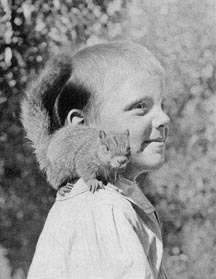
Next Chapter
Book Contents
Return to Bob' Page
